(I hope some English posts are OK while I try to improve my German language skills?)
There is not one ‘perfect EDC light’. With many different choices of size, user interface, output and runtime, it is sometimes very difficult to choose.
Thanks to Fenix, this choice has become a little easier, as they have released the EDC Flashlight Pack containing two of their classic, and recently updated, best-selling, quality, EDC torches. These give you the choice of the very simple E01 which is compact with long runtime, and the LD01, with three output levels and fantastic performance from an AAA light.
PART 1 – Initial Impressions:
There are many copies of the LD01, but they do not come close to the fit and finish of the LD01, and nowhere near the performance. This latest version uses the Cree XP-G R4 LED with 72 Lumens output.
Two things immediately strike you about the LD01, the silkiness and ease of operation, and the beautiful smooth bright beam. Beam tint is very natural in appearance and easy on the eyes.
The head turns very smoothly, and it is easy to operate the LD01 one handed. Being slightly longer than some other AAA EDC lights actually makes it more comfortable to hold and use.
The E01 is smaller and lighter than the LD01 and is quite a different concept. It uses a Nichia GS 5mm LED without a glass lens, instead the LED is recessed in a cone-shaped unpolished reflector. The construction and design of the E01 gives the impression of a super tough light that will keep on running. The E01’s beam is slightly on the cool side, especially compared to the LD01. Used by itself this is not so noticeable.
What is in the box:
The typically well presented Fenix box
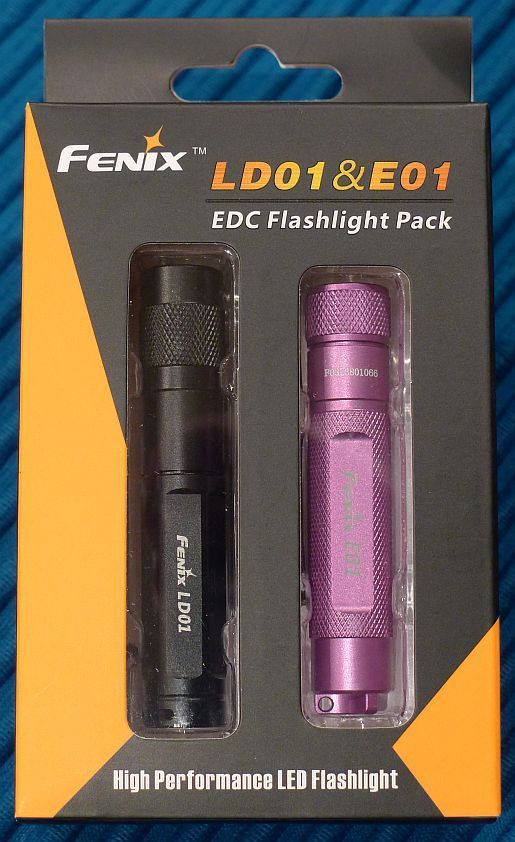
The plastic carrier tray out of the outer sleeve
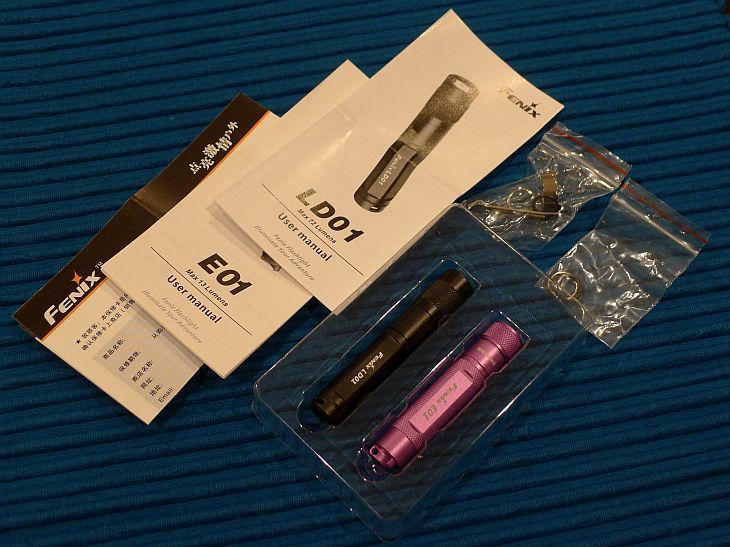
The LD01 comes with two spare o-rings, split ring and a stainless steel clip, the E01 has a single spare o-ring and a split ring. Both sets of instructions are included.
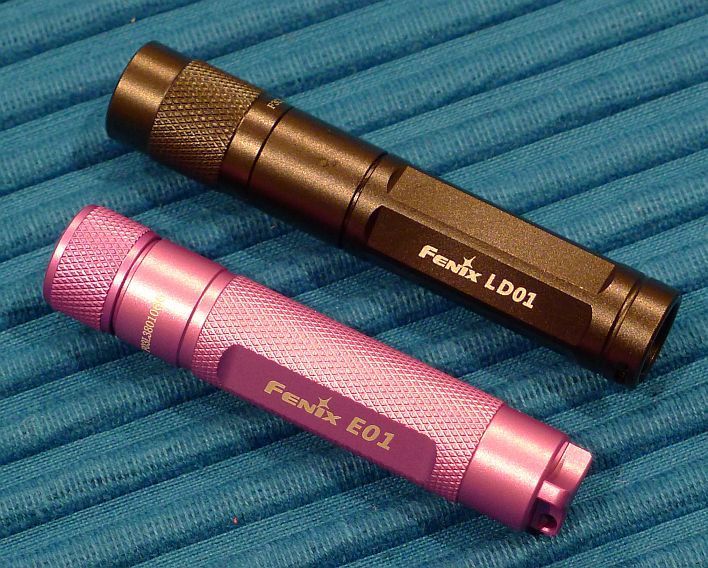
The LD01s LED is well centred, and the reflector comes right up to the LED dome (unlike other lights where the reflector only comes up to the edge of the LED support).
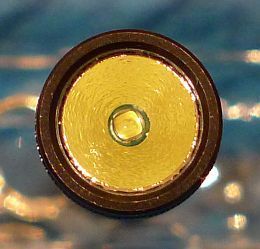
The E01’s lens-less LED
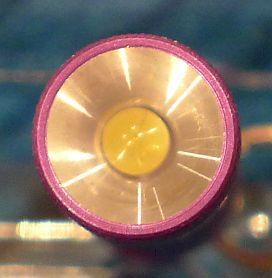
Looking inside:
With the head removed you can see the positive and negative contacts of the LD01
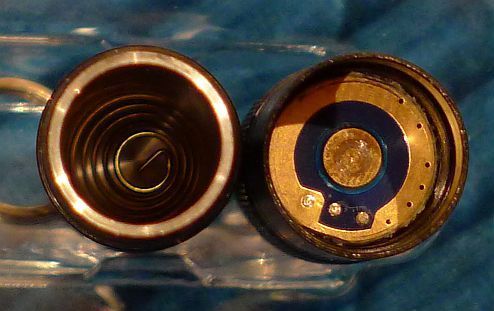
The LD01’s threads
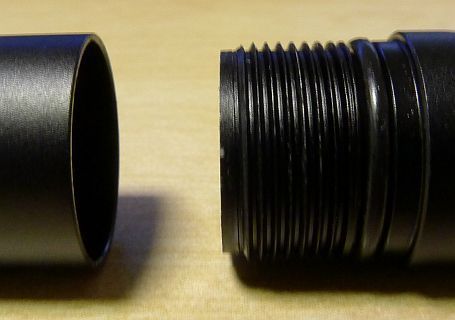
With the head removed you can see the positive and negative contacts of the E01
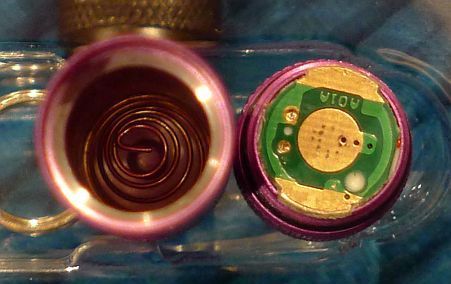
The E01’s threads
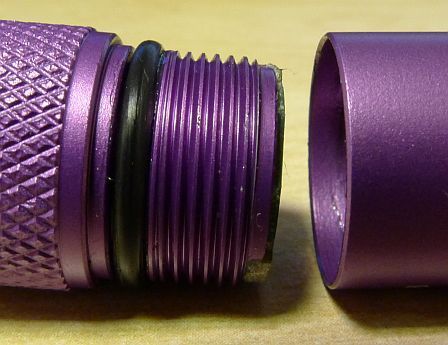
Fitting the LD01’s clip:
The stainless steel clip supplied for the LD01 fits very tightly, and however careful you are, fitting it will scratch the body, and taking it off again will make more marks.
My personal preference is to not use the clip, but it is strong and well finished and will keep the LD01 securely clipped if you do use it.
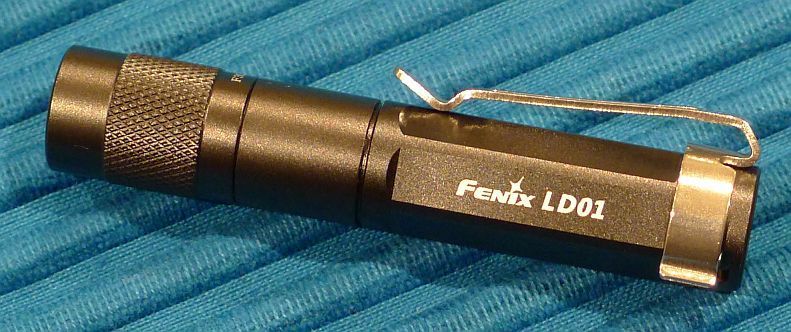
Modes and User Interface:
The user interfaces are very different which is why the EDC Flashlight Pack works so well, giving you the choice or either or both.
The LD01 is a three mode twisty light. Twist to turn on and it comes on in Medium (26Lm). Twist off and on again to get Low (3 Lm), and once more to get High (72Lm). If the light is left off for more than 2s or so it defaults back to medium.
There has been much discussion about which is best between L-M-H, or M-L-H for the order of the outputs. One argument is that you should always start with the lowest output as typically your eyes will be adapted to the dark, however personally I find I use medium output the most, so the fact that the LD01 comes on in medium is very convenient (for me). If you really do need low, then simply covering the front of the light while you select low prevents compromising your night vision, and this can be quickly selected as it is the second mode.
The E01 in contrast has only a single output level, so is the simplest light to use and to lend to others. Twist on and twist off.
The single output level, though low by current standards, is a good compromise in being bright enough to be useful and low enough not to blind you if your eyes are dark adapted. The beam is quite diffuse so provides good area lighting at close distances. The other benefit of the constant 10Lm output is long reliable runtime.
Batteries and output:
Both take AAA batteries and will work with alkalines and NiMH and there is no significant measurable difference in output between these types of battery. As both are specified as current controlled output then this is exactly as expected. I have been using NiMH as my preference is for rechargeable batteries.
The LD01’s high output is surprisingly bright for a single normal AAA battery and noticeably brighter than the popular iTP A3 as shown very clearly by the lab testing.
The three levels are well spaced, the 3Lm output providing a good low level, the 26Lm medium is excellent for general use and the 72 lumen output is bright enough to light a whole room.
I must mention it again, the beam of the LD01 is exceptional, bright with a very diffuse hotspot giving a really good spread of smooth light.
PART 2 – In The Lab
As in a previous review, I decided to try and quantify the actual beam profile. There are probably many flaws in my method, but it is simple and easy to carry out and seems to provide a good enough comparison.
The method used was to put the light on the edge of a table 1m from a wall, with a tape measure on the wall. The zero of the scale is placed in the centre of the hotspot and a lux meter is then positioned at points along the scale, with the measurements recorded. Beam shots are often taken with the light shining on a flat white wall, so this method is simply measuring the actual intensity across the beam on a flat surface, not the spherical light emission.
The results are then plotted on a graph.
For the best throw you want to see a sharp peak with less of the distracting spill. For the best flood light the trace should be pretty flat.
Here the LD01 is shown next to the E01 and for comparison the popular iTP A3. You can clearly see how the LD01 has a much wider hotspot and much more light in the spill when compared to the A3. The E01’s output is much lower and quite an even flood of light.
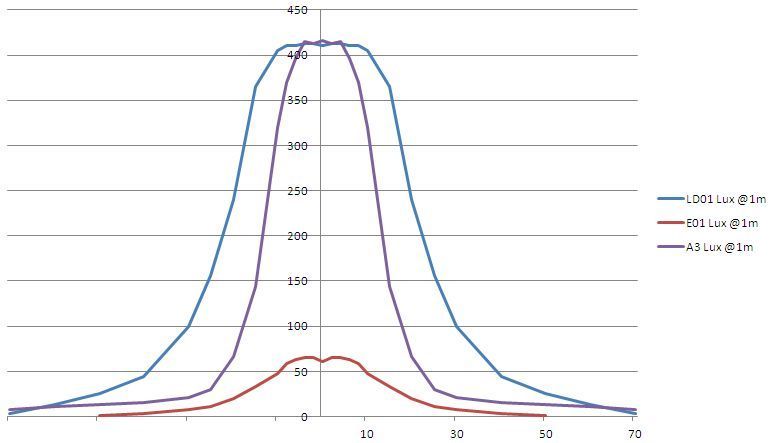
Taking this a little further, I calculated an approximate factor to apply to the lux measurements, as each measurement gets further from the centre of the beam, it corresponds to a larger area onto which the light is falling. It seems to me that this should also be taken into consideration, so I applied these area corrections and came up with this odd looking graph.
The key quantity here is the area under the graph line. This should correspond to the total light output. Here you can see the diffuser has put more light energy into the spill and widened the hotspot.
The LD01 has a much larger area under the line than the A3 representing a significantly greater output.
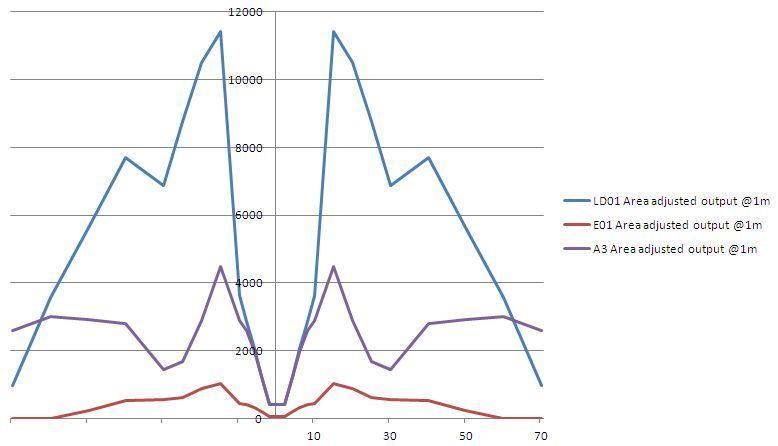
PART 3 – The beams
LD01:
The LD01’s beam is very well formed and is incredibly good for such a small reflector. Nicely smooth across the beam with a soft brighter centre rather than a hotspot (unlike the iTP A3 used for comparison here which has a very defined hotspot).
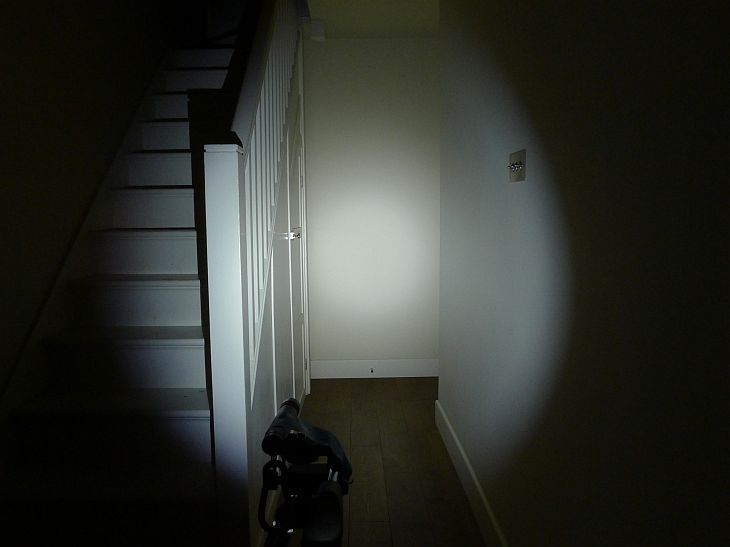
For comparison this is the iTP A3 on high with the same exposure. Strangely, in the photo the spill looks wider than the LD01, but as the hotspot is relatively much brighter than the spill the beam seem narrower to the eye, with the LD01 lighting a much larger area than the A3. The LD01 is really worth the extra cost over the A3.
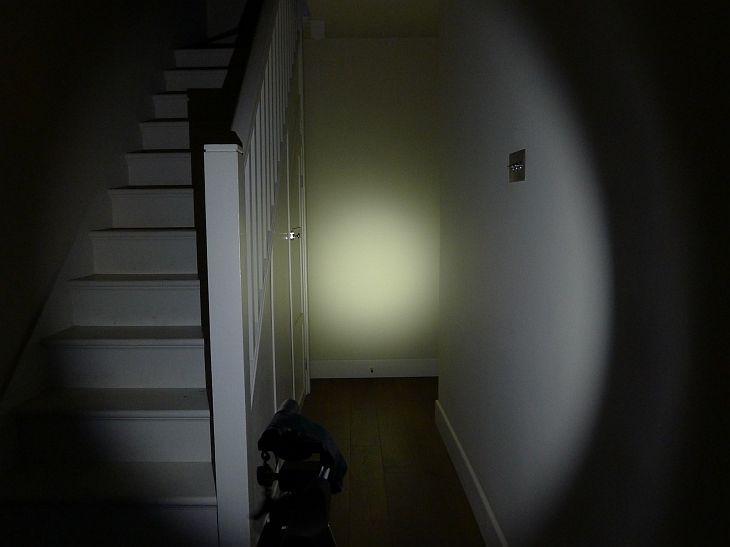
E01:
Compared to the LD01, the E01 may appear totally eclipsed, but it has its place. Again shown here with the same exposure as the previous beam shots (ISO400, F/8, 1s) it is of course much less bright, but it is outputting 10Lm compared to the 72Lm of the LD01.
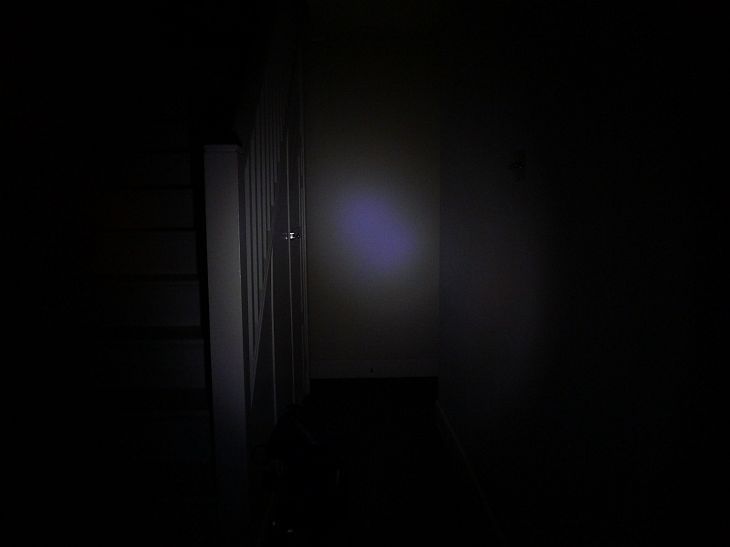
PART 4 – EDCing them
Looking at them and a few graphs doesn't tell you much about what they are like to use and how they perform in different situations.
An EDC torch is going to fulfil different roles than larger heavier duty torches. The most common requirement of an EDC torch is being small and easy to carry. Both of these AAA based lights are compact enough to fit alongside your keys, in a pocket or handbag and go unnoticed.
The LD01 and E01 are excellent EDC lights and what is even better, is having the choice of either, or you might end up carrying both.
Each of us will have different every-day tasks for a light, be it as a back-up for a larger light, lighting the path to and from a car, helping get a key into a lock, peering down a drain, looking inside computing hardware or the boot of your car, the list is endless.
The LD01:
The output of the LD01 is impressive and the beam really is one of the best I have seen for an EDC. As a famous advert campaign said ‘why have cotton when you can have silk?’ and the LD01 is silk. A real pleasure to use, and it encouraged me to find unnecessary reasons to use it.
The E01:
Compared to the LD01, the E01 can at first seem inferior, but in using both of them regularly, the E01 gives you a confidence that regardless how tough the going gets it will keep on lighting the way and just seems to run and run and run.
The beamshot may make the beam look too weak, but of course your eyes also adapt to the lower light level, so in real use the difference is not so marked.
Once the battery has run down to a certain point the output level drops, but it will keep on working for many more hours to come, meaning you won’t get left in the dark.
I’ll update post 2 of this thread once I have some more comments to add....
There is not one ‘perfect EDC light’. With many different choices of size, user interface, output and runtime, it is sometimes very difficult to choose.
Thanks to Fenix, this choice has become a little easier, as they have released the EDC Flashlight Pack containing two of their classic, and recently updated, best-selling, quality, EDC torches. These give you the choice of the very simple E01 which is compact with long runtime, and the LD01, with three output levels and fantastic performance from an AAA light.
PART 1 – Initial Impressions:
There are many copies of the LD01, but they do not come close to the fit and finish of the LD01, and nowhere near the performance. This latest version uses the Cree XP-G R4 LED with 72 Lumens output.
Two things immediately strike you about the LD01, the silkiness and ease of operation, and the beautiful smooth bright beam. Beam tint is very natural in appearance and easy on the eyes.
The head turns very smoothly, and it is easy to operate the LD01 one handed. Being slightly longer than some other AAA EDC lights actually makes it more comfortable to hold and use.
The E01 is smaller and lighter than the LD01 and is quite a different concept. It uses a Nichia GS 5mm LED without a glass lens, instead the LED is recessed in a cone-shaped unpolished reflector. The construction and design of the E01 gives the impression of a super tough light that will keep on running. The E01’s beam is slightly on the cool side, especially compared to the LD01. Used by itself this is not so noticeable.
What is in the box:
The typically well presented Fenix box

The plastic carrier tray out of the outer sleeve

The LD01 comes with two spare o-rings, split ring and a stainless steel clip, the E01 has a single spare o-ring and a split ring. Both sets of instructions are included.

The LD01s LED is well centred, and the reflector comes right up to the LED dome (unlike other lights where the reflector only comes up to the edge of the LED support).

The E01’s lens-less LED

Looking inside:
With the head removed you can see the positive and negative contacts of the LD01

The LD01’s threads

With the head removed you can see the positive and negative contacts of the E01

The E01’s threads

Fitting the LD01’s clip:
The stainless steel clip supplied for the LD01 fits very tightly, and however careful you are, fitting it will scratch the body, and taking it off again will make more marks.
My personal preference is to not use the clip, but it is strong and well finished and will keep the LD01 securely clipped if you do use it.

Modes and User Interface:
The user interfaces are very different which is why the EDC Flashlight Pack works so well, giving you the choice or either or both.
The LD01 is a three mode twisty light. Twist to turn on and it comes on in Medium (26Lm). Twist off and on again to get Low (3 Lm), and once more to get High (72Lm). If the light is left off for more than 2s or so it defaults back to medium.
There has been much discussion about which is best between L-M-H, or M-L-H for the order of the outputs. One argument is that you should always start with the lowest output as typically your eyes will be adapted to the dark, however personally I find I use medium output the most, so the fact that the LD01 comes on in medium is very convenient (for me). If you really do need low, then simply covering the front of the light while you select low prevents compromising your night vision, and this can be quickly selected as it is the second mode.
The E01 in contrast has only a single output level, so is the simplest light to use and to lend to others. Twist on and twist off.
The single output level, though low by current standards, is a good compromise in being bright enough to be useful and low enough not to blind you if your eyes are dark adapted. The beam is quite diffuse so provides good area lighting at close distances. The other benefit of the constant 10Lm output is long reliable runtime.
Batteries and output:
Both take AAA batteries and will work with alkalines and NiMH and there is no significant measurable difference in output between these types of battery. As both are specified as current controlled output then this is exactly as expected. I have been using NiMH as my preference is for rechargeable batteries.
The LD01’s high output is surprisingly bright for a single normal AAA battery and noticeably brighter than the popular iTP A3 as shown very clearly by the lab testing.
The three levels are well spaced, the 3Lm output providing a good low level, the 26Lm medium is excellent for general use and the 72 lumen output is bright enough to light a whole room.
I must mention it again, the beam of the LD01 is exceptional, bright with a very diffuse hotspot giving a really good spread of smooth light.
PART 2 – In The Lab
As in a previous review, I decided to try and quantify the actual beam profile. There are probably many flaws in my method, but it is simple and easy to carry out and seems to provide a good enough comparison.
The method used was to put the light on the edge of a table 1m from a wall, with a tape measure on the wall. The zero of the scale is placed in the centre of the hotspot and a lux meter is then positioned at points along the scale, with the measurements recorded. Beam shots are often taken with the light shining on a flat white wall, so this method is simply measuring the actual intensity across the beam on a flat surface, not the spherical light emission.
The results are then plotted on a graph.
For the best throw you want to see a sharp peak with less of the distracting spill. For the best flood light the trace should be pretty flat.
Here the LD01 is shown next to the E01 and for comparison the popular iTP A3. You can clearly see how the LD01 has a much wider hotspot and much more light in the spill when compared to the A3. The E01’s output is much lower and quite an even flood of light.

Taking this a little further, I calculated an approximate factor to apply to the lux measurements, as each measurement gets further from the centre of the beam, it corresponds to a larger area onto which the light is falling. It seems to me that this should also be taken into consideration, so I applied these area corrections and came up with this odd looking graph.
The key quantity here is the area under the graph line. This should correspond to the total light output. Here you can see the diffuser has put more light energy into the spill and widened the hotspot.
The LD01 has a much larger area under the line than the A3 representing a significantly greater output.

PART 3 – The beams
LD01:
The LD01’s beam is very well formed and is incredibly good for such a small reflector. Nicely smooth across the beam with a soft brighter centre rather than a hotspot (unlike the iTP A3 used for comparison here which has a very defined hotspot).

For comparison this is the iTP A3 on high with the same exposure. Strangely, in the photo the spill looks wider than the LD01, but as the hotspot is relatively much brighter than the spill the beam seem narrower to the eye, with the LD01 lighting a much larger area than the A3. The LD01 is really worth the extra cost over the A3.

E01:
Compared to the LD01, the E01 may appear totally eclipsed, but it has its place. Again shown here with the same exposure as the previous beam shots (ISO400, F/8, 1s) it is of course much less bright, but it is outputting 10Lm compared to the 72Lm of the LD01.

PART 4 – EDCing them
Looking at them and a few graphs doesn't tell you much about what they are like to use and how they perform in different situations.
An EDC torch is going to fulfil different roles than larger heavier duty torches. The most common requirement of an EDC torch is being small and easy to carry. Both of these AAA based lights are compact enough to fit alongside your keys, in a pocket or handbag and go unnoticed.
The LD01 and E01 are excellent EDC lights and what is even better, is having the choice of either, or you might end up carrying both.
Each of us will have different every-day tasks for a light, be it as a back-up for a larger light, lighting the path to and from a car, helping get a key into a lock, peering down a drain, looking inside computing hardware or the boot of your car, the list is endless.
The LD01:
The output of the LD01 is impressive and the beam really is one of the best I have seen for an EDC. As a famous advert campaign said ‘why have cotton when you can have silk?’ and the LD01 is silk. A real pleasure to use, and it encouraged me to find unnecessary reasons to use it.
The E01:
Compared to the LD01, the E01 can at first seem inferior, but in using both of them regularly, the E01 gives you a confidence that regardless how tough the going gets it will keep on lighting the way and just seems to run and run and run.
The beamshot may make the beam look too weak, but of course your eyes also adapt to the lower light level, so in real use the difference is not so marked.
Once the battery has run down to a certain point the output level drops, but it will keep on working for many more hours to come, meaning you won’t get left in the dark.
I’ll update post 2 of this thread once I have some more comments to add....




 .
.